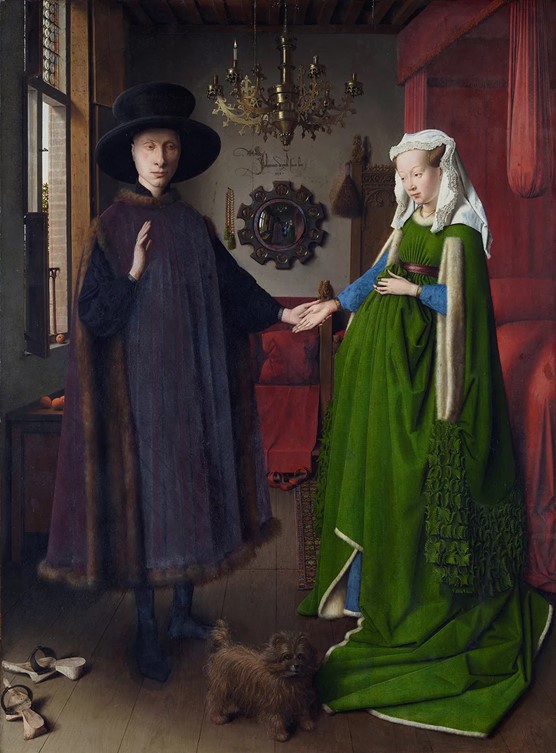
Portrait of Giovanni Arnolfini and his Wife, 1434, Oil on oak, 82 x 60 cm, National Gallery, London https://www.thehistoryofart.org/jan-van-eyck/arnolfini-wedding/
When the time comes for me to introduce my students to Jan van Eyck’s Portrait of Giovanni Arnolfini and his Wife, I start with his flamboyant signature, Johannes de Eyck fuit hic. 1434 – Jan van Eyck was here. 1434, inscribed immediately above the mirror on the portrait’s background wall. Unpretentious words… but how artfully do they draw attention to his extraordinary skills as a painter and a storyteller! https://www.nationalgallery.org.uk/paintings/jan-van-eyck-portrait-of-a-man-self-portrait
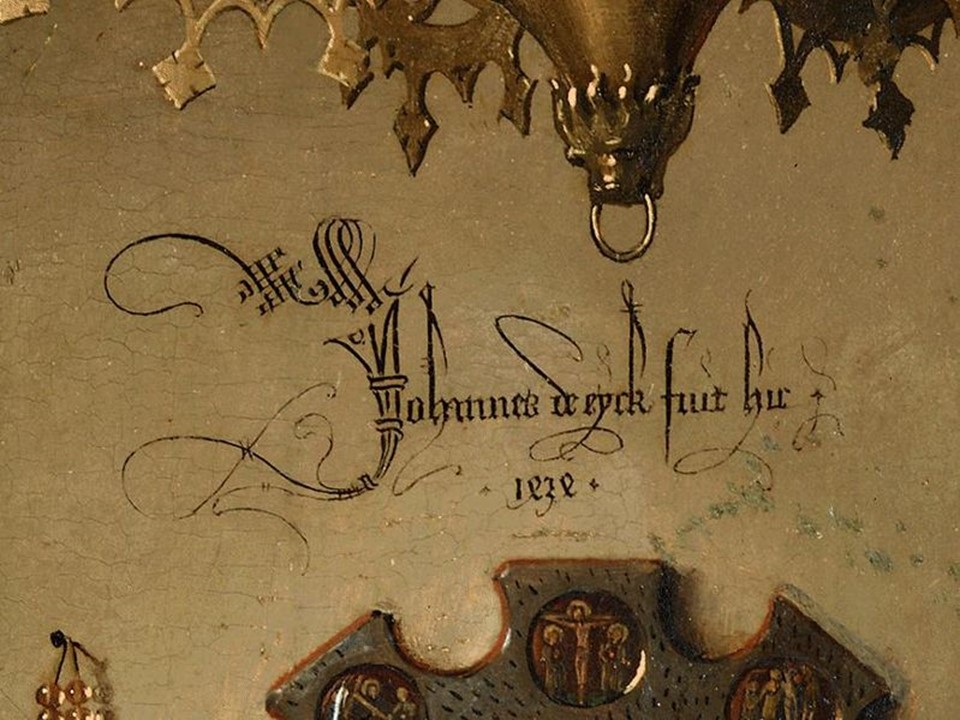
Portrait of Giovanni Arnolfini and his Wife (detail of inscription), 1434, Oil on oak, 82 x 60 cm, National Gallery, London
https://en.wikipedia.org/wiki/File:The_Arnolfini_Portrait,_d%C3%A9tail_(6).jpg
Then, I am in trouble… I look at my students and I am flooded with questions, I do not have the precise answers. Is this exactly the reason why the Arnolfini Portrait is so attractive? How do I proceed?
“Jan van Eyck is credited with originating a style of painting characterized by minutely realistic depictions of surface effects and natural light. This was made possible by using an oil medium, which allowed the building up of paint in translucent layers, or glazes.” These two sentences by the National Gallery in London embody the essence of van Eyck’s painting style and technique. I like to read them to my students emphasizing his contribution to Western European Art. Information about his training and his life is scarce, we do know, however, that he was a member of the gentry class and that by 1425 he lived at Bruges and Lille as a court painter to Philip the Good, Duke of Burgundy. We also know that in 1428 he traveled to Portugal to paint Philip the Good’s future wife, Isabella of Portugal. https://www.nationalgallery.org.uk/artists/jan-van-eyck
I still hesitate… and start with the background, the decorative details, the room itself! Easier to say than do…
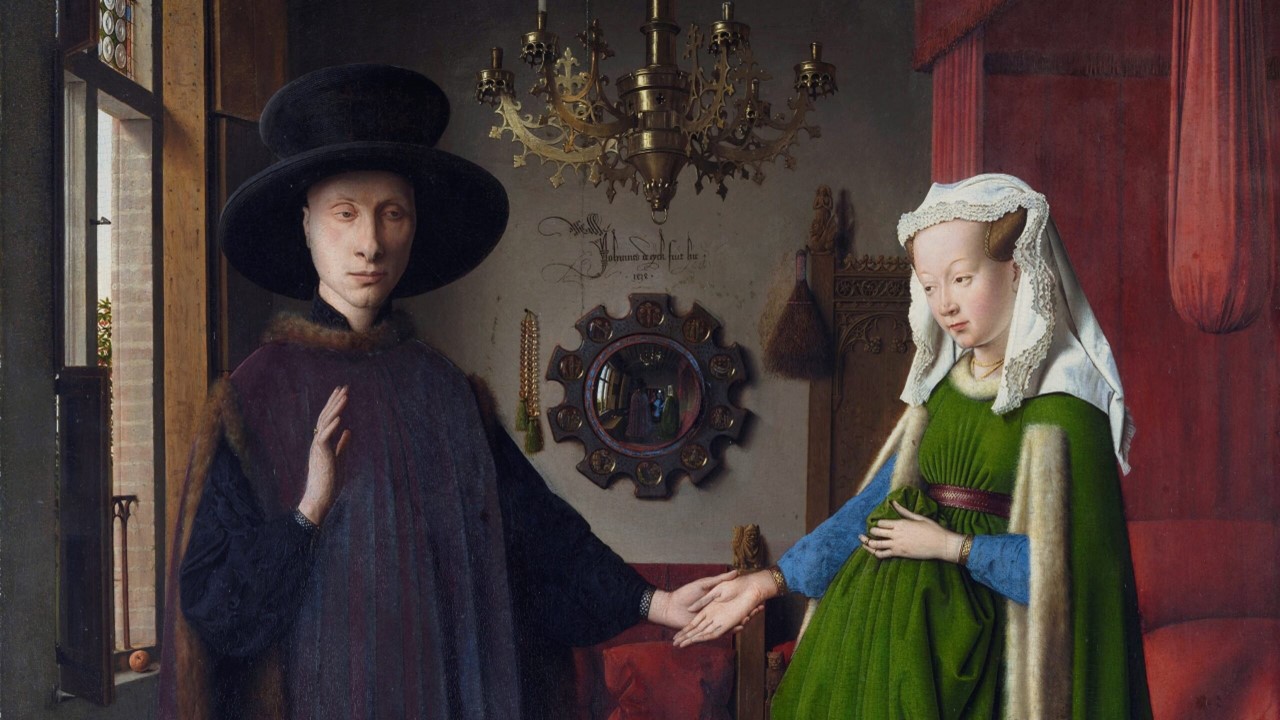
Portrait of Giovanni Arnolfini and his Wife (upper half), 1434, Oil on oak, 82 x 60 cm, National Gallery, London https://www.dailyartmagazine.com/the-arnolfini-portrait/
First impressions… This seems to be a luxurious room in a house of brick, lit up by a window that opens onto a garden with a cherry tree, glimpsed through the open shutters. Colourful light comes in through the glass window at the top, with clear bulls-eye pieces set in blue, red, and green stained glass. What an amazing display of wealth and “hidden symbolisms”…
Let’s start with the impressive, bronze chandelier, that has one lit candle, which represents the seeing eye of God. Consider the mirror, decorated with scenes from the Passion of Christ, unblemished so as to symbolize the piety of Mary, the Mother of God. The wooden sandals… could they imply a “sacred” ground, or are they another evidence of incredible wealth? Could the small dog between the couple symbolize marital fidelity? Last but not least… the figure of St. Margaret carved on the finial of the big chair by the bed is the patron saint of pregnancy and childbirth, while the cherry tree painted outside the window is a symbol of love! https://www.nationalgallery.org.uk/paintings/jan-van-eyck-the-arnolfini-portrait and https://www.artstor.org/2017/06/06/the-many-questions-surrounding-jan-van-eycks-arnolfini-portrait/
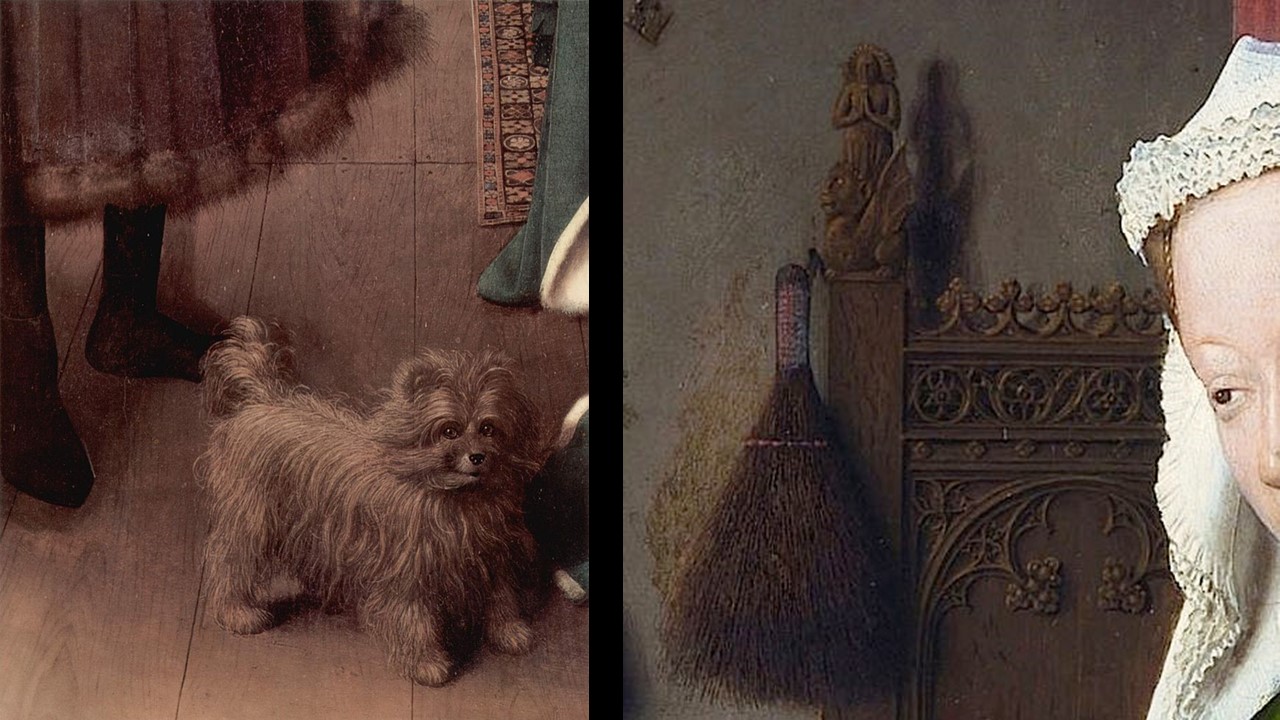
Portrait of Giovanni Arnolfini and his Wife (details of the dog and St. Margaret), 1434, Oil on oak, 82 x 60 cm, National Gallery, London
https://en.wikipedia.org/wiki/Arnolfini_Portrait#/media/File:Jan_van_Eyck_009.jpg
https://oeuvremagazinecom.wordpress.com/2017/05/03/the-symbolic-meaning-of-the-arnolfini-wedding/
The Arnolfini room is full of smaller or bigger luxuries. The bed, for example, covered with expensive red woolen cloth dominates the scene along with ornately carved furniture, covered with red cushions and fabric. An intricately woven Oriental rug on the floor, oranges by the window, and beautiful rosary beads hanging next to the mirror… are all signifiers of great wealth in 15th century Belgium. https://www.nationalgallery.org.uk/paintings/jan-van-eyck-the-arnolfini-portrait and https://www.artstor.org/2017/06/06/the-many-questions-surrounding-jan-van-eycks-arnolfini-portrait/
The difficult questions must be addressed… Who are the people in this luxurious, very personal setting? So many questions… and so many diverse answers!
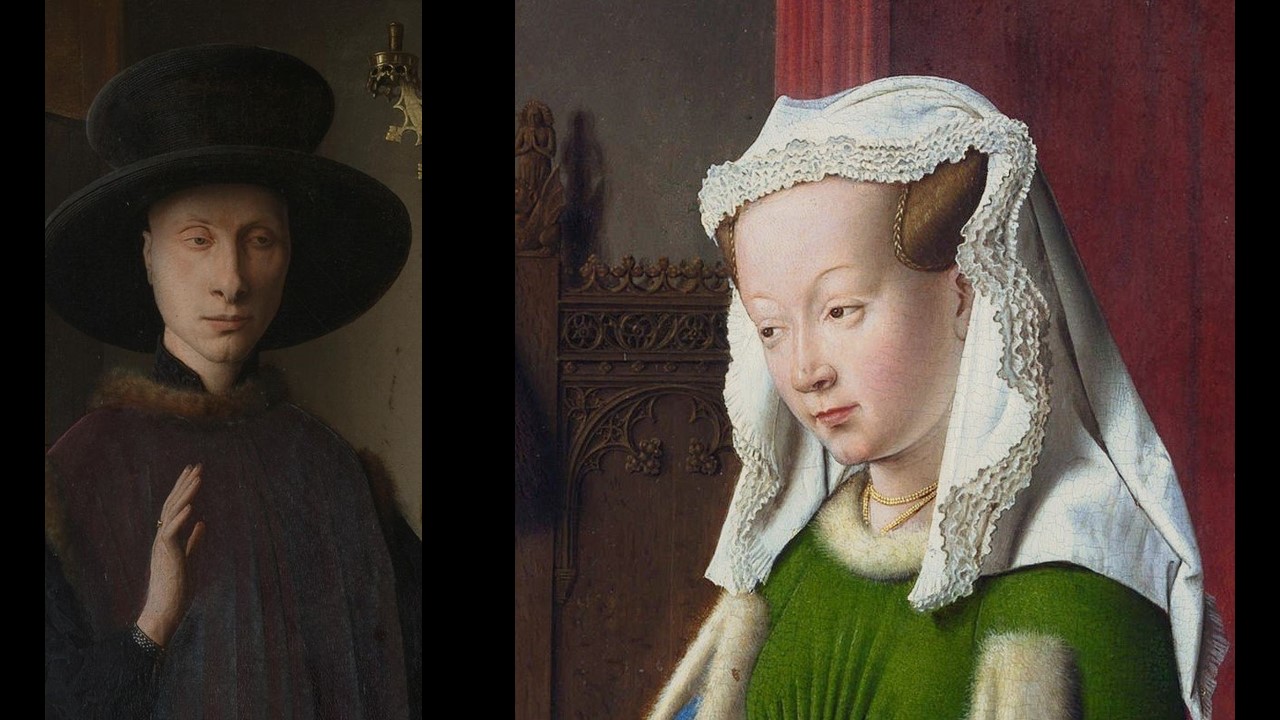
Portrait of Giovanni Arnolfini and his Wife (portraits), 1434, Oil on oak, 82 x 60 cm, National Gallery, London
https://www.artble.com/imgs/b/9/e/222687/249875.jpg and https://www.dailyartmagazine.com/the-arnolfini-portrait/
They are clearly, according to the National Gallery in London, husband, and wife, and for many years the painting was understood as representing a marriage ceremony, though not anymore. From early on the painting was identified as showing one ‘Hernoul le Fin’ or ‘Arnoult Fin’. The most likely candidate is Giovanni di Nicolao di Arnolfini, known as Giannino or Jehannin, who would have been in his late thirties in 1434. The lady is probably his second wife, whose identity is unknown. The large round mirror that hangs right in the centre of the composition is stunning! Its convex glass shows not just the compressed and contorted room but also two men coming in through a door behind us. Immediately above the mirror is the flamboyant signature: Johannes de Eyck fuit hic. 1434 (‘Jan van Eyck was here. 1434’). Are the two men in the mirror Jan van Eyck, in a red turban, and his servant, arriving on a visit? https://www.nationalgallery.org.uk/paintings/jan-van-eyck-the-arnolfini-portrait
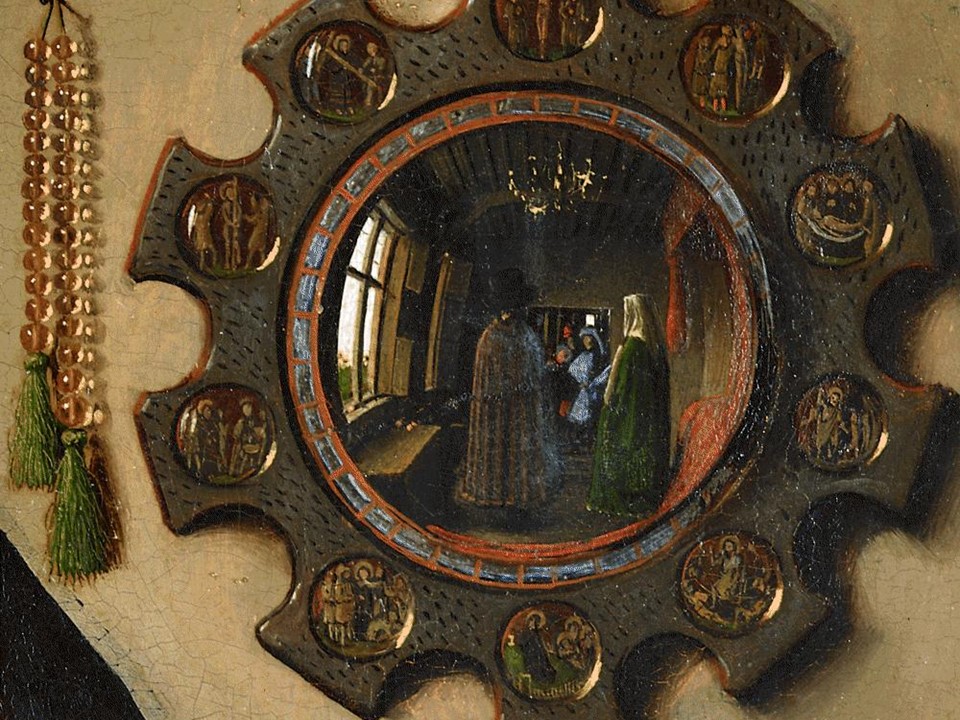
Portrait of Giovanni Arnolfini and his Wife (detail of mirror), 1434, Oil on oak, 82 x 60 cm, National Gallery, London
https://el.m.wikipedia.org/wiki/%CE%91%CF%81%CF%87%CE%B5%CE%AF%CE%BF:The_Arnolfini_Portrait,_d%C3%A9tail_%282%29.jpg
So many questions…
For a Student WRAP Activity on the Portrait of Giovanni Arnolfini and his Wife, please… Check HERE!
An informative Video (3:59 min) presentation of the Arnolfini Portrait prepared by the National Gallery in London… https://www.youtube.com/watch?v=wM6d9BOj4Ww
If you want to explore the Bibliography on the Portrait of Giovanni Arnolfini and his Wife… start with: Jan van Eyck’s Arnolfini Portrait, by Erwin Panofsky, The Burlington Magazine for Connoisseurs, Vol. 64, No. 372 (Mar. 1934), pp. 117-119+122-127 (9 pages) https://www.jstor.org/stable/865802